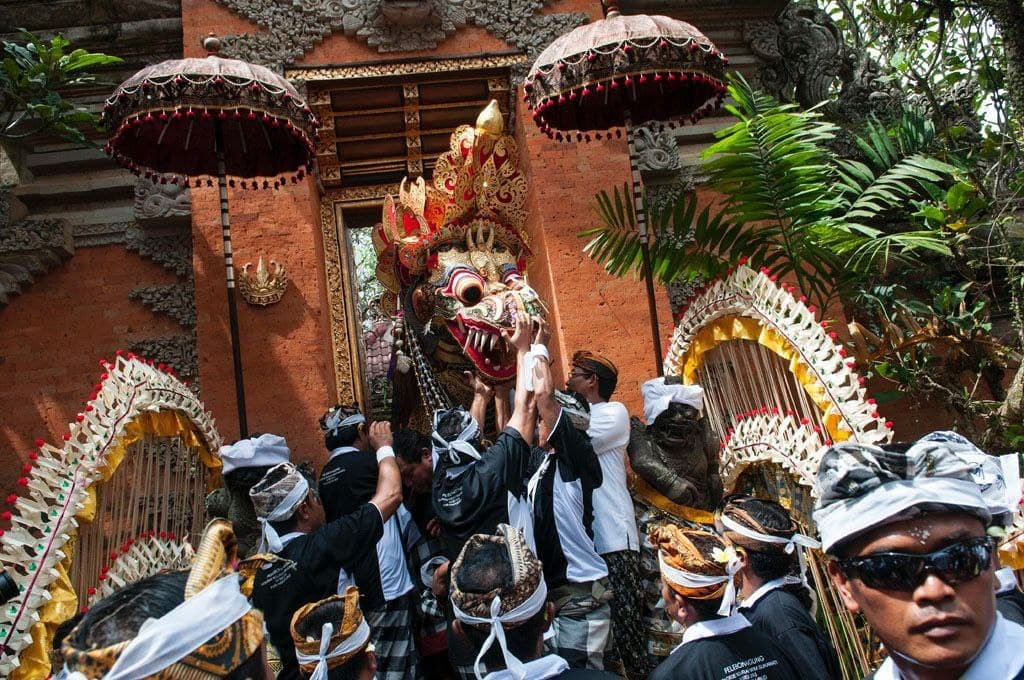Popular Reads
Top Results
Can't find what you're looking for?
View all search resultsPopular Reads
Top Results
Can't find what you're looking for?
View all search resultsNaga Banda: Myth, local wisdom and power of king
Change text size
Gift Premium Articles
to Anyone
A
s one of the world’s top tourist destinations, culturally and historically rich Bali continues to attract tourists from far and wide. Revisiting its cultural objects will allow travelers to learn new things, such as local wisdom.
For example, Naga Banda found in cremation ceremony.
Naga Banda is a funereal stretcher shaped like a dragon, called bade in Balinese, which is used to transport the body of a Balinese king to the crematorial grounds in the ngaben or pelebon ceremony.
In fact, naga banda is a mythological creature that takes the form of a large snake with a long tail. This type of bade is different from that used to transport the bodies of ordinary members of the Balinese Hindu community, which are usually shaped like lions, tigers or oxen. The Naga Banda is exclusive because it is only for kings, in particular the descendants of King Dalem Waturenggong.
The Naga Banda has special symbolism, not just as a myth but also for its philosophical meaning as a reflection of power relationships.
Legend of Naga Banda
The tradition of using Naga Banda to escort the body of the king during the pelebon ceremony dates to the Gelgel Kingdom.
Dalem Waturenggong was a large 15th-century Balinese kingdom with its palace at Puri Sweca Linggarsapura in Gelgel village, Klungkung. Its king ruled from 1460 1550 with his spiritual advisor, the priest Ciwa, and the Buddhist monk Purohito.
These two royal priests were expected to provide spiritual guidance to their king as well as fulfil his wish to hold the Homa ceremony.
King Waturenggong expressed this wish to a Buddhist priest from the Majapahit Kingdom named Dang Hyang Angsoka, who did not accede to his wish. Instead, it the priest’s son Dang Hyang Astapaka who did.
In his role as the Great King, Dalem Waturenggong wanted to test the knowledge of Purohito for his suitability to be appointed as the royal priest. So the king made a hole in the palace courtyard and placed a goose in it, covering the hole so that the goose’s calls would sound like the roar of a dragon.
When Purohito arrived, a sound that resembled the roar of a dragon came from within the hole. Dalem Waturenggong asked the priest about the sound, that the people of the kingdom had become restless because they had heard the strange sounds coming from the hole. Purohito answered, "It is the voice of a dragon.”
Hearing the priest's answer, the king and his servants all laughed, because they knew it was the voice of a goose. To their surprise, when the hole was uncovered, out came a large dragon measuring 118 meters long.
Everyone was amazed and frightened. Purohito then caught the dragon and told the king, "Don't be afraid, this dragon is Naga Banda, who will guide you to Nirvana,” and then he released the dragon.
This is the origin story of the use of Naga Banda in Bali’s royal pelebon ceremony. The legend of Naga Banda has been passed down through the generations in Gelgel village and is still believed today.
The village community believes that the Naga Banda incident occurred at Ketepeng Sumur, which is now known as Taman Sribaginda Sumur Ketepeng, located in Merajan Agung Gelgel, about 2.6 kilometers south of Semarapura, Klungkung.
Philosophical Meaning
Naga Banda consists of the words naga and banda. The word naga comes from Sanskrit and is derived from the root word nag meaning “snake”.
Snakes are predators that kill their prey with venom, while dragons are often depicted as breathing fire. The dragon in traditional Balinese culture is also a symbol of the worldly or material nature.
Meanwhile, banda means binding or shackle (Paramadhyaksa, 2011). So together, Naga Banda means “large snake” (dragon) that binds worldly things. In the context of its function as funereal stretcher for transporting the king's body, the Naga Banda symbolizes the dragon that binds the king to his worldly ties.
Balinese kings have close ties to their people. A king is bound by the material nature of "the intention to rule" over his people.
This bond interferes with the spirit's journey to the heavenly realm and must be broken. That is why, during the final procession of transporting the king’s body to the cremation ground, the priest overseeing the ceremony releases arrows in all directions toward Naga Banda in order to break these worldly ties.
Freed from its worldly ties, Naga Banda can then escort the king’s spirit to Nirvana. The royal pelebon ceremony thus “releases” the king’s spirit from the wordly to the heavenly realm. Worldly ties such as the intent to rule and the king’s close relationship with his people are broken so he can be led to eternal peace in heaven.
The Naga Banda philosophy can be interpreted as local wisdom about the bonds between physical and spiritual things, as well as the process of “releasing” in order to reach heaven.
Power Relationship
If we look closely, the roots of the Naga Banda tradition cannot be separated from the relationship between a leader and the people. In this case, Naga Banda is a gift from the royal priest to his king to serve as his vehicle to the realm of Nirvana. Meanwhile, the standard of the bade used for common people is determined by the king. The power relationship between the royal elite, namely the priest and the king, has prevalence in funereal ceremonies and rituals.
The people simply accept the regulations as determined by a priest, who is considered most knowledgeable about religious matters and ceremonial procedures. This is how this magical socio-religious element is manifest in the power relationship between traditional leaders and the masses.
Nevertheless, the positive lesson here is that the tradition of the pelebon ceremony reflects the dynamics, diversity and plurality of Balinese culture based on the soroh (clan) social structure as well as the autonomy of Balinese villages.
Writer: Dr. Drs. I Made Mardika, M.Si
Lecturer of the Public Administration Postgraduate Program at Warmadewa University in Denpasar, Bali.










